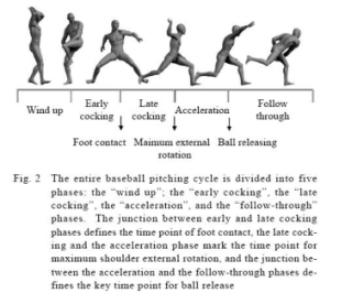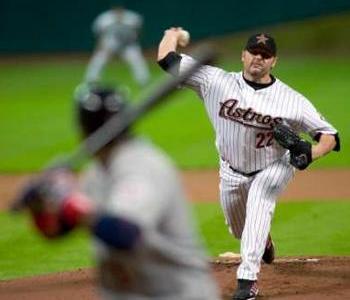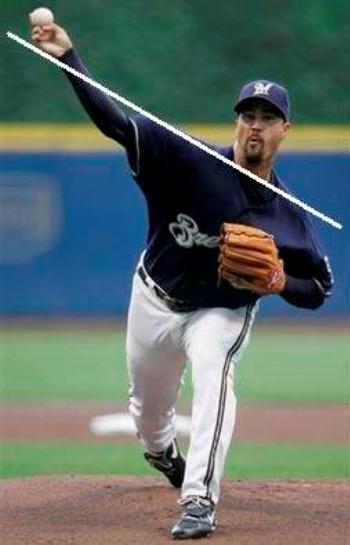|
This piece is 11 years old and, in that time, has become out of date.
So I'm working on updating it.
In sum, pitching mechanics instruction has changed enough —
due in large part to a BAD idea called
Positive Disconnection that causes a serious flaw called
Flat Arm Syndrome if not
Early Torso Rotation — that the milestone that I used to
use to judge the
Timing of baseball pitchers is no longer accurate.
Among other things, I am in the process of laying
out my — updated and latest — method for
Judging Timing in Baseball Pitchers.
A Revised Baseball
Pitching Cycle (2009)
Many people are working to understand why pitchers are being injured.
The hope is that this knowledge can help us understand how to drive down the rates of
injuries that pitchers experience.
The problem is that many of the people who
are working to solve the riddle of pitching injuries do not have
a complete understanding of the baseball pitching cycle.
This is evidenced by the diagram below, which appeared in a
professional journal and which is like others like the
NPA's Sequence of critical events.1

The Baseball Pitching Cycle
The thing to pay attention to is the fourth figure from the left,
which is labeled "Maximum External Rotation". Notice how the figure's Pitching Arm Side
(PAS) forearm is vertical and pointing upwards as if he was giving someone a
"high five". The problem with this
representation is that it's not what you see — and isn’t even
physically possible — in a high-level throw.

Roger Clemens
As the photo above of Roger Clemens demonstrates, in a high-level throw you
will see 180 or so degrees of external
rotation in the Pitching Arm Side upper arm at this moment in
time, not the 90 degrees of external rotation
that is shown in the fourth figure in the diagram above.
The representation of the fourth figure may represent a
common misunderstanding
of the nature of a pitcher's arm slot. As I explain in my piece
The Great Arm Slot Myth, many
people believe that a pitcher's arm slot is determined by the
amount of flexion or extension (or, more simply, bend) in the elbow at the release point.
The truth is that, due to centrifugal force, every pitcher's
elbow is fully extended at the release point. As a result, a
pitcher's arm slot is determined by the amount of shoulder tilt,
and not the angle of the elbow, at the release point.

Shoulder Tilt Determines Arm Slot
When Does the Acceleration
Phase Start?
Another obvious problem with the commonly-accepted baseball pitching cycle
is the placement of the start of the acceleration phase.

The Baseball Pitching Cycle
In many of the baseball pitching cycle diagrams that have
been used in various journal articles, such as "Valgus Torque in
Youth Baseball Pitchers: A Biomechanical Study" by Sabick et al
in the May/June 2004 edition of the Journal of Shoulder and
Elbow Surgery, the start of the Acceleration phase is set as the
point of maximum external rotation.
The problem with setting the start of the Acceleration phase
at this moment in time is that in truth most of the acceleration of the pitcher's
shoulders has been completed by this moment in time. In fact, the point
of maximum external rotation is usually considerably nearer to the moment where the
deceleration of the shoulders begins than
when the acceleration of the rotation of the shoulders begins.
It is also inaccurate to break up the
Late Cocking and Acceleration phases into two separate phases
due to the fact that it is the acceleration of the rotation of
the shoulders that causes the activity that is observed during
the Late Cocking phase (e.g. the external rotation of the
Pitching Arm Side upper arm and the laying back of the
Pitching Arm Side forearm). In other words, the Acceleration phase actually starts
during what is currently being labeled as the Late Cocking
phase.
Finally, the delineation between the Early Cocking and Late Cocking phases is
at least quite subtle and often quite arbitrary. More
importantly, the differences in a pitcher's arm action and when
and how they transition from Early Cocking to Late Cocking may
have important injury implications. As a result, it is best to
not put a break point in the sequence at this moment in time out
of fear of disguising potentially relevant information.
A Revised Baseball Pitching Cycle
I propose a Revised Baseball Pitching Cycle that is based on
what I have learned about what the best pitchers actually do when they
throw the ball. The hope is to produce something that is...
- More accurate.
- Simpler.
I accomplish this by redefining the baseball pitching cycle
and focusing on movements and moments in time that are...
- Common to most pitchers.
- Representative of true phase/stress changes.
- Most significant to the health of a pitcher's arm.
The goal is to clear up the numerous misconceptions
that exist about what pitchers' arms actually do as they throw
the ball.
I will do this using video of a student of former St.
Louis Cardinals pitcher Greg Mathews. It was estimated by
Mathews that this pitcher was throwing 80 MPH.

The 5 Phases of the Pitch - Overview
Preparation
The Preparation phase of the Revised Baseball Pitching Cycle
begins with the movement of the pitcher's Glove Side (or stride)
foot and concludes at the top
of the leg lift. This is because, while the Wind-Up and Set are
two different initial positions and sets of preparatory
movements, they both end up with the pitcher at the top of the
leg lift (although the height of the leg lift will often vary
depending on whether the pitcher goes from the Wind-Up or Set
position).

The 5 Phases of the Pitch - Preparation Phase
I have labeled this phase
the Preparation phase, and not the Wind-Up phase as has been
done in the past, because the Wind-Up is a discrete and defined set of preparatory
movements that are quite different than the movements that you
see when a pitcher starts from the Set (aka Stretch) position.
Preparation is a more neutral term that takes into account
throws that start from both the Wind-Up and Set positions.
Stride
The Stride phase of the Revised Baseball Pitching Cycle begins at the
top of the leg lift and concludes with the planting of the GS heel.

The 5 Phases of the Pitch - Stride Phase
I chose this point in time as a phase break because
pitchers' mechanics are largely the same, regardless of whether
they go from the Wind-Up or the Set (aka Stretch) positions,
from the top of the leg lift onward.
Acceleration
The Acceleration phase of the Revised Baseball Pitching Cycle begins
with the planting of the heel of the Glove Side
foot and ends at ball release. The planting of the heel of the
GS foot is
an important point in time because in most (c. 90%) cases the
rotation of the shoulders, and thus the acceleration of the
pitching arm, starts with the planting of the heel of the GS
foot.

The 5 Phases of the Pitch - Acceleration Phase
In a high-level throw, at the start of the Acceleration phase
the pitcher’s hips have opened on average 15 to 30 degrees (and
in rare cases, like Tim Lincecum, 45 to 60 degrees) while their
shoulders are still closed and have not started rotating. In
other words, a high-level
pitcher’s hips rotate ahead of their shoulders. This stretches
the muscles of the Core and, because of the Stretch-Shortening
Cycle, increases the force with which the
muscles of the Core can contract.
At the start of the Acceleration phase, when the pitcher is at what
is commonly referred to as the High-Cocked or Power Position, the Pitching Arm Side (PAS)
upper arm is generally abducted between 80 and 90 degrees and is externally rotated between 75 and 90
degrees. However, in some cases at the start of the the
Acceleration phase you will see significantly more abduction of
the PAS upper arm and significantly less external rotation (ER)
of the PAS upper arm (sometimes 0 degrees of ER or in rare cases
even a fair amount of Internal Rotation).
As the Acceleration phase begins and the pitcher’s shoulders
start to rotate, the Pitching Arm Side upper arm externally
rotates an additional 90 (or in rare cases, like Billy Wagner, more) degrees. The
amount of external rotation that occurs during the Acceleration
phase depends in part upon the amount of external rotation at the
start of the Acceleration phase, which can vary widely from
pitcher to pitcher.
Because there is so much, possibly significant, variability
in the positions of pitchers' arms with respect to external
rotation during this phase, in my opinion it is preferable to simply label this phase the Acceleration phase and not
subdivide it into the Early Cocking and Late Cocking phases. That is because while
the amount of external rotation at the moment the GS foot will
vary widely, and possibly significantly, from pitcher to
pitcher, in most cases the planting of the GS foot will begin
the rotation of the shoulders.
Deceleration
The Deceleration phase of the Revised Baseball Pitching Cycle
starts at ball release and ends when the pitcher's arm has
decelerated fully.

The 5 Phases of the Pitch - Follow-Through Phase
A pitcher's follow-through does have some injury implications
because it is generally accepted that the longer the
follow-through, the longer the arm has to decelerate. As a
result, less force must be exerted by the muscles in the back of
rotator cuff at any point during the follow-through.
Recovery
The Recovery phase of the Revised Baseball Pitching Cycle starts when
the pitcher's arm has decelerated fully and then rebounds. It
also encompasses the pitcher's movements to get ready to field a
batted ball.

The 5 Phases of the Pitch - Recovery Phase
How a pitcher recovers from a throw
does have some injury implications because the way that a
pitcher recovers from throwing the ball impacts how they are
able to respond to a ball that is hit directly at them (aka a
"come-backer"). For example, a pitcher who recovers with their
glove sticking out behind them and toward Second Base will
obviously be less able to defend themselves than will someone
who finishes with their glove closer to their Glove Side chest.
References
1. Hwai-Ting Lin, Fong-Chin Su, Mari Nakamura and Edmund Y.
S. Chao. COMPLEX CHAIN OF MOMENTUM TRANSFER OF BODY SEGMENTS IN THE BASEBALL PITCHING MOTION. Journal of the Chinese
Institute of Engineers, Vol. 26, No. 6, pp. 861-868 (2003).
|









